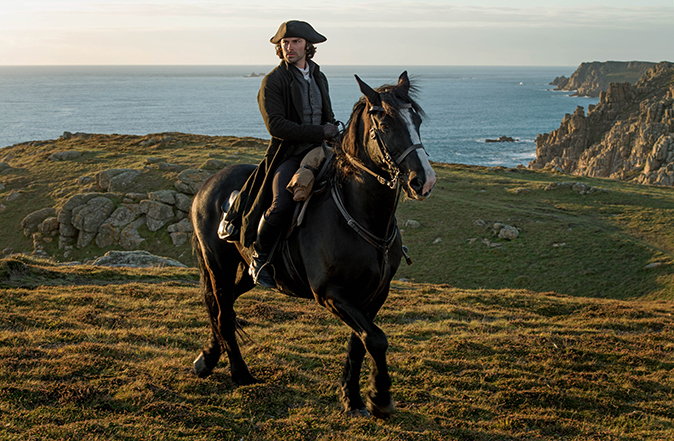How to turn your home into a film location
Welcoming a film crew into your home can bring fame and a little fortune, says Flora Watkins.


When Luckington Court, Wiltshire, was launched onto the market last year the media excitement – long before the rumours that a certain newly-married Royal couple were interested – was as high as when Colin Firth, as Mr Darcy, scrambled out of a lake in that sopping-wet shirt. For this exquisite, creamy Cotswold-stone house near Badminton had played the part of Longbourn, the Bennet family home, in the acclaimed 1995 BBC series of Jane Austen’s Pride and Prejudice.
It’s more than 20 years since the show was compulsory Sunday-night viewing, but Luckington Court’s starring role has generated an extraordinary level of interest.
‘We’ve had people from as far as Canada and America who have been over to look at it,’ confirms Richard Nocton of Woolley & Wallis in Marlborough, who re-launched the house in January, with a reduced acreage, at a guide price of £5,750,000.
‘It is a beautiful country house, now with a manageable amount of land,’ he continues, and, being ‘incredibly private’, could easily be used as a film location again, should the new owners so wish.
Luckington ticks many boxes for location scouts, being close to a big city (Bristol), with rooms and land spacious enough to accommodate a large film crew, plus privacy from curious fans. It also has a head start in the film business, because, as Caroline Lowsley-Williams of Chavenage, near Tetbury, Gloucestershire, explains, ‘filming breeds filming’.

Chavenage is a 16th-century stone manor house with a long and illustrious CV. Currently starring as Trenwith, the Poldarks’ ancestral home in the BBC series, Miss Lowsley-Williams’s father, David, first saw the advantage of bringing in film crews in the 1970s, with Stanley Kubrick’s masterpiece Barry Lyndon.
Nowadays, she estimates there are about 25 days of filming a year at the house. Of course, the income is welcome. ‘We’ve done a bit of roofing and spent some of the money on doing up family portraits,’ explains Miss Lowsley-Williams.
Exquisite houses, the beauty of Nature, and how to get the most from your life, straight to your inbox.
The Poldark team has also decorated rooms ‘that hadn’t been painted for 50 years and made some nice curtains and things’. But it’s through the effect of what she calls ‘telly tourism’ that the family is reaping the greatest benefits. ‘Our visitor numbers have gone up from about 3,200 to 9,000 a year,’ she discloses.
‘However, they can be disappointed that Aidan Turner [who plays Ross Poldark] isn’t around! In the long-term, we’ll probably make more from that than from the filming.’
A great advantage of a house the size of Chavenage is that the family doesn’t need to move out when the film crew moves in. For Christopher and Hanne Gray, whose pretty Georgian house, Higginsbrook, in Co Meath, deputised for the Hampshire home of Jane Austen’s family, Steventon Rectory, in the 2007 film Becoming Jane, the family – and some 13 guests who were descending for Easter – was put up by the film crew in a nearby village.
‘It was great fun, we didn’t mind at all,’ recalls Mr Gray. ‘It was a wonderful experience, not only because of the lovely people who came here to make the film, but the actors themselves [James McAvoy was the love interest for young Jane, played by Anne Hathaway].’
The film crew ‘put back everything they’d undone’ and repainted rooms after the wrap, using Farrow & Ball paints. Members of the family got to star as extras and Mr Gray has happy memories of the excellent on-site catering, something with which Miss Lowsley-Williams concurs. ‘Our dogs change shape during the course of filming!’ she chuckles.
However, one doesn’t need to be the chatelaine of a large period property to get into the film business. Lorna Gatherer Ford, managing director of agency Location Works, represents members of the Historic Houses Association, including Chavenage. But the majority of work, she reveals, is for ‘everyday, lovely family houses, which are mainly used for TV dramas or commercials’.
A good kitchen to film in, she discloses, is ‘one with an island – but the hob needs to be on the island, which is surprisingly hard to find. Otherwise, for a cookery show, all you’d see would be Jamie Oliver’s back!’
Miss Gatherer Ford cites a five-bedroom house in Wandsworth, south-west London, whose owners have earned in the region of £80,000 over the past seven years through hiring it out to film crews.

‘They’re very flexible and have five children, so if a plant pot gets broken, or there’s a scuff on a wall, they’re used to that,’ she enthuses. ‘We always take a damage deposit, however,’ she adds, stressing that anything particularly precious should be put away, or pointed out to the film crew beforehand.
Rates, she explains, vary enormously, from an average of £1,000 to £2,000 per day for a house such as the one in Wandsworth, to between £1,500 and £3,000 for a larger, edge-of-village period property. One of her clients, whose tile-hung Sussex home was used for the forthcoming film Red Joan, starring Judi Dench, directed by Trevor Nunn and inspired by KGB spy Melita Norwood, commanded a fee of £2,000 a day for a shoot that lasted several days.
Filming – unless you’re lucky enough to land a hit TV series – won’t provide a regular income and it can be disruptive. ‘Either you’re up for it and can accommodate the potential intrusion and damage that comes with it, or you’re not,’ counsels Miss Lowsley-Williams. If you are, it can be enormous fun – Mr Gray jokes that he’s been dining out on Becoming Jane for 11 years. ‘We hope it will happen again one day – it was an unforgettable experience.’
Ready for your close-up?
- Are your rooms large enough to accommodate a film crew? Even a small shoot for a TV advert will involve 10–12 people
- Location is key: most clients will want to film close to London, or another centre of production, such as Bristol or Manchester
- Will you have to move out during filming? If not, be aware that in film, 11–12-hour days are standard
- Expect several recces before a location manager decides to use your home – or not
Sign me up!
Location Works (0844 414 5505; www.locationworks.com) Lavish Locations (0333 700 7007; www.lavishlocations.com) JJ Media (020–3773 1648; www.jjmedia.com) Shoot Factory (020–7252 3900; www.shootfactory.co.uk)


